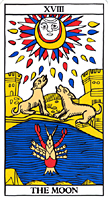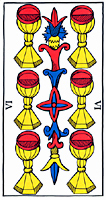Decks (continued)
THE TAROT OF MARSEILLES FAMILY The Tarot of Marseilles family of decks dates from as early as the 17th century, which makes it far older than most decks in use today, including the RWS family of decks and Thoth Tarot (both discussed previously). Traditionally, makers often produced these decks in Marseilles, France (hence their name), to play the family of games called Tarot. Later, in the 18th-century, people began to use them regularly for divination and esoteric purposes.
Makers used wood blocks to print the outlines that defined the visual forms, and stencils to fill them with colors. In any deck, they used only a few colors. This process, in part, accounts for their frequent rustic appearance. Tarotists regularly use reproductions and modern adaptations of decks from this historic family to this day. They are particularly popular in France.
Although differences exist, the essential design is remarkably similar from deck to deck. Colors, however, sometimes vary, especially among modern adaptations. The Major Arcana and court cards include illustrations that may assist in divination and related activities. For example, see the Moon (illustration, extreme left). However, compared to, say, RWS decks, the numeric cards generally do not. The Six of Cups (see illustration, near left) essentially depicts six cups – period. (Compare it to the Six of Cups from a RWS deck by clicking here.) For this reason, some Tarotists avoid these decks. However, others report that numeric cards which essentially have suit signs only, facilitate a free, intuitive approach, sometimes based on numerology. If you elect to use a Marseilles deck, you may wish to read a book specifically written with it in mind, e.g., The Magical World of the Tarot. In Marseilles decks Justice is numbered VIII; and Strength, XI. Typically, the Fool has neither a number nor zero.
Illustrations (above, left to right): The Moon and Six of Cups from Tarot of Marseilles (Carta Mundi/ U.S. Games).
If you want a traditional deck with a long history and are comfortable with numeric cards which essentially show suit signs only, a Marseilles deck may be right for you, and you may wish to consider the following ones.
Ancien Tarot de Marseille (Grimaud/Cartes France) by Paul Marteau, is a 20th-century adaptation of an 18th-century deck and especially popular in France (see illustration, left). Cards measure approximately 2 5/8 x 4 7/8 inches; titles are in French. To view more cards from it, click here.
Illustration (left): L'Amoreux [The Lover] from Ancien Tarot de Marseille (Grimaud/Cartes France).
Le Tarot de Marseille (Naipes Heraclio Fornier) by Maritxu de Guler and A. Aymerich, includes an unusual palette of bright colors and an updated, three-dimensional look (see illustration, right). Cards measure approxmately 2 3/8 x 4 3/8 inches; titles are in French. To view more cards from it, click here.
Illustration (right): La Papesse [The Papess] from Le Tarot de Marseille (Naipes Heraclio Fornier). The Papess corresponds to the High Priestess.
Tarot Classic (U.S. Games Systems & AGM�ller, ISBN 0913866547) is a 20th-century adaptation from an 18th-century design (see illustration, left). Cards measure approximately 2 3/8 x 4 3/8 inches. To view more from it, click here.
Illustration (left): The Fool from Tarot Classic (U.S. Games Systems & AGM�ller).
Tarot of Marseilles (U.S. Games Systems & Carta Mundi, ISBN 0913866601) is adapted from a deck published by Jean Dodal, circa 1700 (see illustrations, above). Cards measure approximately 2 5/8 x 4 7/8 inches. To view more from it, click here.
To view cards side-by-side from all aforementioned Marseilles decks, click here. (This page makes comparison easy, but is graphics-intense; it may take a minute or two to download.)
The guide continues with more about decks . . . click here.
NEXT PREVIOUS CONTENTS E-MAIL AUTHOR HOME

Copyright � 2002 James W. Revak. All rights reserved. (12/10/02).

